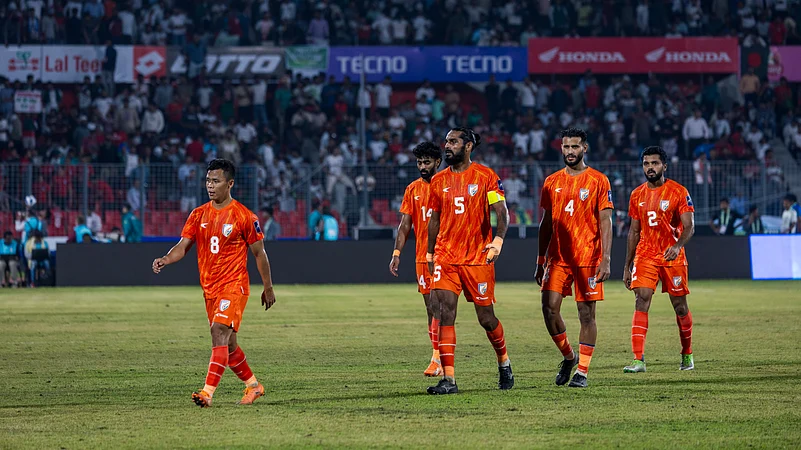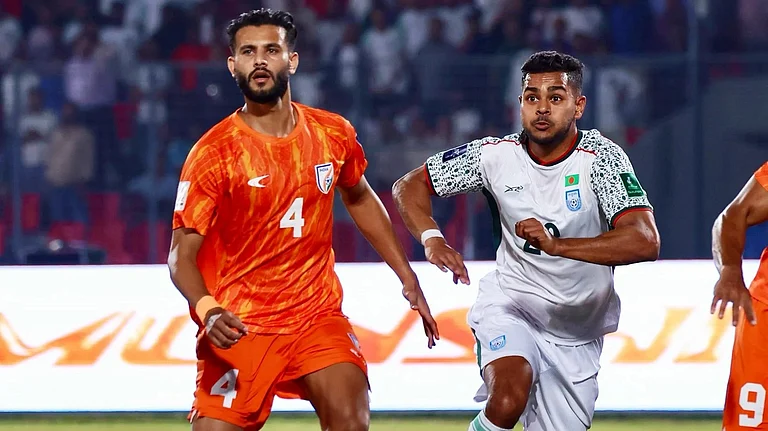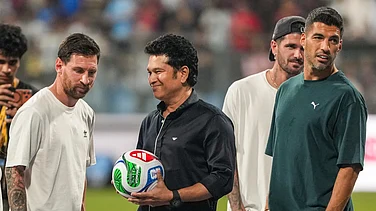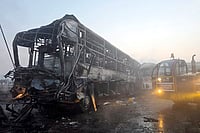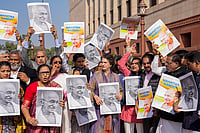
India finished last in a qualifying group with Bangladesh, Hong Kong and Singapore, nations with more modest resources and far smaller pools of players
What began as a contractual dispute between the All India Football Federation and its long-time commercial partner has unravelled into a full-blown structural collapse, leaving Indian Super League in the lurch
The collapse of the domestic calendar is not a logistical hiccup; it is an existential fracture
There are defeats that sting and defeats that strip a national team bare. India’s loss to Bangladesh in Dhaka belongs to the latter. A match against a side ranked far below India should never have been a referendum on the state of the sport. Yet, the 0–1 scoreline felt less like an upset and more like an audit, a cold inspection of a footballing nation now slipping into 142nd in FIFA rankings, its lowest standing in nearly a decade. The number is not merely a statistic; it is a verdict on years of promises, plans, and patriotic slogans that have dissolved into air.
For months, the national team drifted without competitive football, waiting for a domestic league that never began and training within an ecosystem that had quietly ceased to function. The loss in Dhaka did not happen on the pitch. It happened in meeting rooms, boardrooms, and courtrooms long before kick-off, when the basic scaffolding of the sport began to come apart.
India finished last in a qualifying group with Bangladesh, Hong Kong and Singapore, nations with more modest resources and far smaller pools of players. To call this a setback is to avoid the truth. This is humiliation engineered by administrative paralysis; a failure so comprehensive that it cannot be disguised by rhetoric or deferred to yet another committee.
The Absence That Defines Everything
Football cannot survive in a vacuum, and India has spent the past year trapped inside one. The Indian Super League, the country’s highest professional competition, has remained suspended in something resembling a bureaucratic coma. What began as a contractual dispute between the All India Football Federation (AIFF) and its long-time commercial partner has unravelled into a full-blown structural collapse.
The Supreme Court verbally restrained the federation from renewing its commercial agreement, a freeze that turned out to be fatal. The tender issued to find a new partner attracted not a single bidder. For a league once marketed as the engine of Indian football’s rebirth, this was not just a setback; it was a public verdict of no confidence.
Even the I-League, which was supposed to serve as the stable spine of Indian football, found itself mired in absurdity. Last season ended in a championship controversy so protracted with disputes, appeals, and counter-appeals stretching for weeks that the title felt less like a sporting triumph and more like a legal technicality. When a league cannot even crown a champion without committee intervention, it signals a system losing the ability to perform the most basic functions of competition.
The deterrents elsewhere were unmistakable: an INR 37.5 crore minimum guaranteed payment that no serious investor found realistic; a governance model that concentrated authority but dispersed responsibility; and a tender process that seemed designed to repel rather than invite participation. As doubts multiplied, clubs froze salaries, coaching staff departed mid-preparations, scouting networks were dismantled, and some of the country’s oldest institutions suspended operations altogether.
At training grounds that once echoed with whistles, instructions, and the optimism of pre-season, the silence is now broken only by the wind. Grass grows freely where players should have been preparing for a season that never arrived.
The collapse of the domestic calendar is not a logistical hiccup; it is an existential fracture. Without a league, there is no match fitness. Without match fitness, there is no competitive national team. And without a competitive national team, the federation’s grand aspiration that India will be “among the top four in Asia by 2047” reads less like a vision and more like theatre.
Players Left To Fend For Themselves
When the system stalls, players do not have the luxury of waiting for clarity. They go where the football is, or where the money still trickles in. And so, over the past months, professional footballers scattered across the country, appearing in prize-money tournaments in West Bengal, Assam, Arunachal Pradesh, Mizoram, Nagaland and every corner of India, willing to offer a few thousand rupees for a day’s labour.
These tournaments look festive from afar, but they are built on risk. Grounds are uneven, medical support is uncertain, and insurance is absent. A mistimed tackle or a bad landing can tear a ligament, fracture an ankle, or quietly end a career. For men who expected to spend the year in televised matches, guided by sports scientists and paid on time, this is not a temporary adjustment. It is a descent into precarity that few imagined when they first put on a club jersey.
One player from Manipur, once a regular in the ISL, now turns out for a small local side in Assam simply because the league that was supposed to sustain him has evaporated. His words are painfully simple: “I am not playing for glory anymore. I’m playing for rice, rent, and the next week.” In a different year, this would have sounded like an exaggeration. Today, it is the daily arithmetic of survival.
This is not the sporting future that a “new India” proclaims. It is one thing for a nation to fall short of international standards; it is another to abandon the people who train, travel, and sacrifice in the country’s name.
The desperation sharpened when Sunil Chhetri, a man who has carried Indian football on his shoulders for nearly two decades, posted a public appeal on Instagram. The message was measured, almost painfully dignified, yet it read like a cry from inside a collapsing house. Chhetri wrote that players were “angry, frustrated, and distressed,” but above all, “desperate to play.” For someone who has rarely indulged in public criticism, his words struck with the force of truth. When even he steps forward, it is because silence has become impossible.
The rare collective statement from national team veterans soon followed. These are not men given to theatrics; their careers have been shaped by a stoic discipline that resists complaint. Yet they found themselves asking, almost pleading, for the season to begin. The request was minimal: let us train, let us compete, let us earn our wages. Beneath the restraint lay a harsher reality: they also want to survive.
A sporting ecosystem reveals its values not when its stars lift trophies, but when its players face uncertainty. Indian football’s values, at this moment, stand exposed, and the cost is being borne by its most devoted professionals.
A Decay Long In The Making
Crises do not fall from the sky; they are manufactured, one frail decision at a time. The collapse of Indian football is not an accident of fate or a temporary market failure. It is the outcome of a federation that has treated governance as a political project and the sport as an afterthought.
For years, the AIFF has been more absorbed in elections, court cases, and constitutional tinkering than in the mundane work of running competitions on time. Successive committees, rival factions, and their political patrons in Delhi turned the federation into a miniature arena of power, where controlling votes inside the annual general meeting often mattered more than building leagues outside it. Reform became a word deployed in affidavits and press conferences, not in dressing rooms and training pitches.
Vision 2047 is the purest expression of this disconnect. On paper, it is immaculate: India will be a top-four Asian power; football will become a ‘sport of the masses’; integrity, transparency and excellence will guide every decision. There are slides on data analytics, national playing philosophies, and stakeholder engagement. Yet, the same federation that promises a world-class ecosystem could not secure a single bidder for its top league because it misjudged the market, overestimated its leverage, and wrote a tender that loaded risk onto others while hoarding control for itself.
Politics shapes these choices. State associations, whose delegates decide who runs the AIFF, expect patronage and protection, not disruption. Commercial partners are seen less as collaborators and more as sources of guaranteed money. When the Supreme Court finally insisted on cleaning up this arrangement, the federation responded not by building trust with clubs and players but by drifting, waiting for judges and retired justices to rescue its finances. It was in this vacuum that the ISL tender failed, leaving an INR 50-crore hole in the AIFF’s budget and pushing the entire domestic calendar towards paralysis.
The consequences trickled down quickly. Bengaluru FC’s pair of public statements captured the fragility of the system better than any audit. In August, the club announced it was indefinitely suspending salaries of first-team players and staff because the league’s future was unclear, a step it called “very difficult,” taken after years of climbing an “uphill” financial slope. Only weeks later, after a tentative resolution, another statement confirmed that all pending payments were cleared and pre-season would resume. This was not a dramatic gesture by an irresponsible club; it was a forced response by one of India’s most professional outfits to a federation that had allowed politics and indecision to push the sport to the brink.
When clubs toggle salaries on and off like a light switch, the problem is not just economic. It reveals a deeper political culture in which those who wield authority rarely bear the cost of their decisions. Administrators can wait out court hearings and internal negotiations; players and staff cannot. Yet, the people making the rules are insulated by their proximity to government, federations, and the Olympic bureaucracy, while those on the field are left to negotiate rent, school fees, and loans.
The symptoms of this decay have been visible for years. Crowds shrank as fans sensed the league’s fragility. Broadcasters renegotiated contracts downward. Clubs finished season after season in the red. Youth academies struggled for support even as AIFF documents spoke grandly of “pathways”. The national team plateaued and then slid, its trajectory mirroring that of a federation that had lost interest in anything that did not translate into immediate political capital.
Meanwhile, other sports, governed with fewer illusions and sometimes less political interference, moved ahead. Kabaddi, wrestling, boxing, badminton, and even athletics built clearer systems of talent and competition. Football, despite its global glamour, became the anomaly, a major Indian sport weakened not by a lack of love, but by being trapped in the crossfire of federation politics and bureaucratic vanity.
The present crisis is therefore not a sudden misfortune. It is the logical conclusion of a system in which those entrusted with the game spent more energy securing positions and pleasing patrons than building institutions. Indian football did not simply decay; it was allowed, even enabled, to do so.
A Mirror Too Clear To Ignore
The defeat in Dhaka landed with a thud that went beyond football. India walked out of that match ranking 142nd in FIFA's world ranking, carrying no league behind it, and stepped onto the pitch unsure if the season even exists. Bangladesh merely held the mirror steady. What slipped through was the truth of a sport running on fumes.
Players often say, when microphones are off, that uncertainty drains them more than defeat. A bad night can be forgotten. Living from week to week, unsure if income will come through, unsure if the season even exists, wears people down. Footballers are creatures of rhythm, and when the calendar disintegrates, everything else begins to wobble.
This is a country that enjoys the aura of aspiration. We celebrate “new India,” “big dreams,” “global competitiveness,” often without noticing that the institutions meant to deliver them are fraying. Football makes this contradiction impossible to ignore. Smaller Asian nations, with far fewer resources, stitch together functional leagues. India spends months trying to guess when its own season will begin.
A nation of this size should have no trouble imagining itself on the Asian stage. Yet the sport remains stuck in a holding pattern, treated as something that can be revived by the next press conference or strategic document. Meanwhile, a generation of players sees a future slipping sideways, not because they lack the ability, but because the system surrounding them cannot offer the stability any athlete needs to grow.
What Dhaka revealed, in its own blunt way, is that India does not lack desire or talent. It lacks the structures that protect both. Until those are rebuilt with seriousness, not slogans, not committees, not campaigns, defeats will keep accumulating. And the loss will not just be measured in rankings or scorelines, but in the quiet resignation of players who no longer know whether the dream they are chasing has a horizon at all.
The Narrow Road Ahead
What comes next will not be easy work. Indian football has reached a point where nothing short of a rethink will do, and not the kind that arrives in PowerPoints or keeps to familiar talking points. The league will return only when people at the top stop treating management as an afterthought and begin to build a structure that can stand on its own weight. Clubs need to know the season will run from start to finish. Players need contracts that do not dissolve the moment trouble appears. And the federation has to convince those who play, coach, and run the teams that it has finally understood the cost of its own drift.
None of this is complicated in theory. The difficulty lies in changing habits that have settled deep inside the institution: habits of delay, half-decisions, and the instinct to look outward for blame.
For the players, the future is painfully simple. They want a season they can trust, wages that arrive without pleading, and a sense that the sport they have committed their lives to has a place to go. These are not extravagant hopes. They are the minimum any federation owes its professionals. Yet the past year has shown how far this basic expectation has drifted from reality.
What lingers after Dhaka is not the scoreline. It is the feeling that the country has grown accustomed to shrinking standards. A loss that should have unsettled us instead slid easily into the week’s news cycle, as if nothing urgent had been revealed. That quiet acceptance is the real warning. Once a nation stops being troubled by its own decline, the decline settles in and begins to feel normal.
Indian football has not run out of talent. It has run out of time to ignore what has been plain for years. The system will recover only when those in charge recognise that the game cannot survive on residual goodwill. It needs competence, attention, and a willingness to rebuild without excuses. The players will keep waiting in that long tunnel; some will leave, others will endure. Whether the light returns depends entirely on whether the federation decides that this sport is worth the seriousness it has long been denied.
Views expressed in the article are those of the author. Sangmuan Hangsing is a researcher and alumnus of the Kautilya School of Public Policy.






